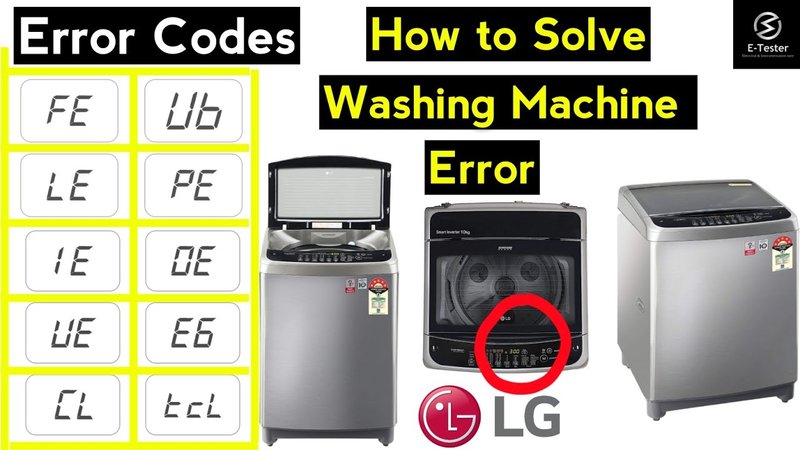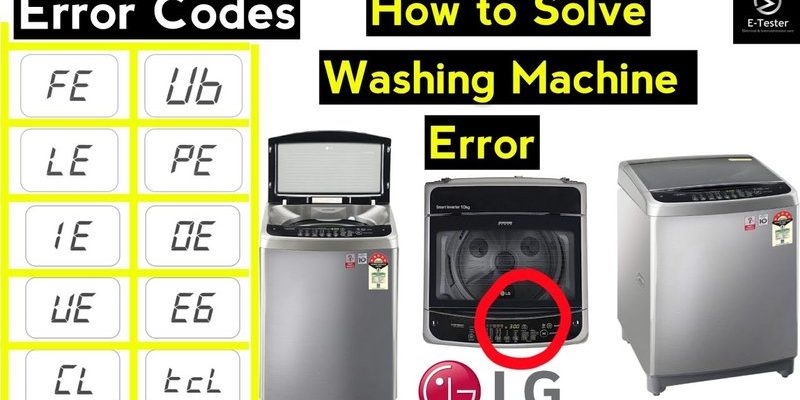
Error codes in washing machines are like a secret language that they use to communicate issues. The “E2” error on an LG washer specifically points to a problem with water draining. Think of it like a sink that refuses to let water down the drain—it could be due to a clog or a malfunctioning part. If you attempt to use the washer without addressing this issue, it could cause more problems down the line, like water leaks or damage to other components. So, let’s decode this mysterious message and figure out if you can still use your machine safely or if you need to hit pause and fix it first.
Understanding the E2 Error Code
When an LG washing machine displays the E2 error code, it’s signaling an issue with draining water. Imagine your washing machine like a bathtub that’s supposed to fill and empty water seamlessly. With an E2 error, something’s blocking the draining process. This could be due to a clogged drainage pump filter, a kinked drain hose, or even a defect in the pump itself. Each of these components plays a crucial role in ensuring that water exits your appliance properly.
You might be wondering why this is important. Well, if the water doesn’t drain out as it should, clothes won’t be rinsed properly, leaving detergent residues behind. Worse yet, stagnant water can cause unwanted odors or even flooding if it manages to overflow. Therefore, ignoring the E2 error could turn a simple inconvenience into a much bigger issue. Therefore, while it might be tempting to continue using the machine “just this once,” it’s best to tackle the root of the problem.
There are several common causes behind the E2 error. For instance, something as minor as a piece of clothing finding its way into the drainage system can block water flow. Alternatively, mineral buildup from hard water can clog up the pipes. Identifying the exact cause may require a bit of investigation, but it’s worth the effort to ensure your washing machine keeps working smoothly.
Steps to Troubleshoot and Fix the E2 Error
Now, let’s talk about what you can do to fix the E2 error. First, you’ll want to turn off the washing machine and unplug it for safety. This step is essential—working with an electric appliance can be hazardous if not done carefully. Once it’s powered down, check the drain hose for any kinks or clogs. Picture the drain hose like a straw; if it’s kinked, water can’t flow through. Untwist any kinks and remove any visible obstructions.
Next, it’s time to examine the drainage pump filter. This is similar to the lint trap in your dryer—it needs regular cleaning to prevent blockages. Depending on your model, you may need to open a small door at the bottom of the machine to access it. Be prepared for some water to come out when you remove the filter, so have a towel handy. Clean any debris and soap buildup from the filter carefully.
If you’ve tried these steps and the E2 error persists, the issue might be more serious, possibly involving the pump motor itself. In such cases, it might be time to call in a professional. A technician can diagnose more complex problems and offer solutions such as repairing or replacing faulty parts. Remember, it’s always better to be safe than sorry, so if you’re not comfortable with DIY repairs, don’t hesitate to seek expert help.
Should You Continue Using Your Washing Machine?
So, can you keep using your washing machine when the E2 error pops up? The short answer is no—at least, not until you’ve investigated and resolved the issue. Continuing to operate the machine without addressing the error could worsen the problem. You might even end up with a flooded laundry room or a damaged appliance, which would be far more expensive and stressful to deal with.
Using the washing machine with an unresolved E2 error is like driving a car with a flat tire. You might get a little further, but eventually, it’s going to cause more harm than good. Your priority should be fixing the issue before running another cycle. This way, you avoid unnecessary wear and tear on your machine and ensure it operates efficiently in the long run.
If you find that the problem persists even after troubleshooting, consider contacting LG customer support for guidance. They might provide insights specific to your model, which can be incredibly valuable. Plus, following the user manual’s maintenance advice can help you prevent future issues, keeping your machine in good working order.
Preventive Measures to Avoid Future Errors
Let’s talk about prevention now—because wouldn’t it be great if you could avoid these headaches altogether? One of the best ways to prevent the E2 error from reoccurring is regular maintenance. Just like you’d service your car to keep it running smoothly, your washing machine benefits from a little TLC too. Regularly checking the drain hose and pump filter for clogs can go a long way in keeping things flowing smoothly.
Another tip is to ensure that you don’t overload your washing machine. Overloading can strain the system, increasing the likelihood of items blocking the drainage. Think of it like trying to stuff too many clothes into a suitcase—it’ll only burst at the seams. Keep your loads reasonable, and your machine will thank you.
Finally, if you have hard water, consider using a water softener. Hard water minerals can build up inside your machine over time, obstructing water flow. By using a water softener, you minimize this risk and enhance the efficiency and lifespan of your washer. By incorporating these preventive measures, you can enjoy hassle-free laundry days without the worry of unexpected interruptions.
